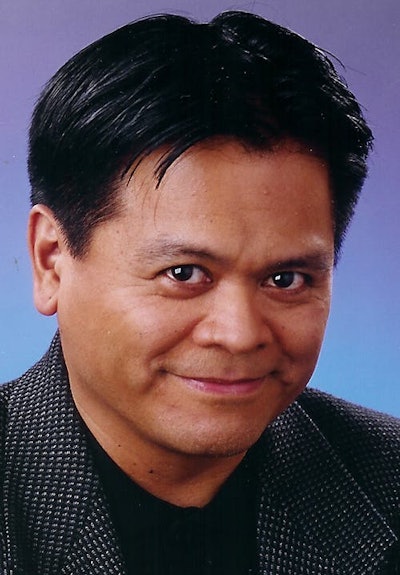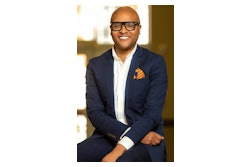If you think I mention Harvard a lot, please forgive me. I did wait until the sixth word in this piece. This restraint may not be much compared to those (mostly white) who incessantly debate, “When do I drop the H-bomb?” as a social calculation so as not to alarm people they are in the presence of an arrogant a—hole.
Forgive them for their false humility. But I don’t use the H bomb to brag. I use it as it was intended. To level the playing field.
If the infamous Jeffrey Epstein and I were in a lineup-- and he was wearing a Harvard T-Shirt as he was wont to do-- who would you pick out as the Harvard alum? Not me. Epstein went to Cooper Union before he taught at Dalton, and before he went to prison. He met Bill Gates on Epstein Island. I was just a Filipino in Bill Gates’ Harvard class.  Emil Guillermo
Emil Guillermo
And now I mention this because I am in a unique position in the never-ending Harvard affirmative action debate. I am the progenitor of bona fide Asian American Harvard legacies.
That’s a fancy way of saying my kids were born with legacy tickets in hand.
If only Harvard let them in. Finally, the legal focus is being placed on the only real indefensible affirmative action that ever existed—the advantage given to legacies.
These are the sons and daughters of alumni primarily. As a group they represent 5 percent of the applicants to Harvard each year, according to the NY Times. But they are around 30 percent of those admitted. Over-represented? Slightly.
67.8 percent of them are also white, according to court records.
That’s why it’s fair to call it affirmative action for whites.
It’s the privileged push.
Now that the Supreme Court has banned the use of race in college admissions for BIPOC applicants, shouldn’t the next step be to go after any admissions policy that shows a profound preference for one race in particular?
The court has paved the way for colorblind, but white legacy policy leaves admissions officers snow-blind.
All they see is white.
We have the lawyers from the Chica Project, the African Community Economic Development of New England, and the Greater Boston Latino Network to thank for this new focus.
They have forced the U.S. Department of Education’s Office of Civil Rights to investigate Harvard under Title VI of the Civil Rights Act of 1964.
It’s an investigation that could lead to a legal battle equal to the one we just had that ended affirmative action for Blacks, Latinos and Asians.
Or it could simply force Harvard to do the right thing--make legacy admissions fairer and more diverse.
In the recent Harvard case, it was the only bit of common ground between the Students for Fair Admissions, the mostly Chinese American students-- led by the white anti-civil rights activist Ed Blum to fight affirmative action--and their counterparts, the pro-affirmative action Asians who allied themselves with the historical fight for civil rights.
Both the AAAA (anti-affirmative action asians) and the PAAA (the pro-Affirmative Action Asians) could agree on that one thing.
What about all those legacies, the majority of whom happend to be white and wealthy, they asked?
When it came up at trial, Harvard wouldn’t budge. It defended legacy admits as being highly qualified. But it was unclear if it meant by grades or bank accounts.
After the SCOTUS decision, SFFA’s Blum was asked about legacy at a news conference. He said he wasn’t a lawyer, then as an aside said that no one sued over legacies because of an issue of standing.
Maybe he was just being coy. Far be it for the white man using Asians to end affirmative action to advocate for an end to legacy admissions that primarily benefit rich whites.
Surely, he must have known there was a way to challenge through the Education Department’s Office of Civil Rights. In the 1980s, that office looked into a complaint that Asian applicants had been discriminated by white legacies. But then sided with the university’s use of legacy admissions.
Now comes this new challenge mounted 40 years later when affirmative action is taken away as a tool for Blacks, Latinos and Asians.
Can legacy/white affirmative policy even be seen as defensible?
Given the school’s endowment which stands at more than $50 billion, Harvard can solve all this simply, starting by installing a colorblind legacy process. They can afford it. Why were white wealthy legacies advantaged over poor ones like me in the first place?
And I don’t mean to insult the poor. I live a comfortable and normal middle-class life. There are 4 million Filipinos out of 400 million Americans. That’s the only 1 percent to which I am a part.
So put my kind of legacies in the mix, and lotterize the process. Allow applicants to “qualify” for the chance at a truly random shot at admissions. What can be more fair? Under those circumstances, you’re likely to get a better shot at a diverse class after 40 years of affirmative action.
As Harvard legacies, my children were all more qualified than me. Grades, test scores. One had overcome a case of dyslexia so severe, only to graduate from an International Baccalaureate program with honors. He was told in third grade he’d never be able to read.
My legacies are also the picture of diversity: Half-Filipino and half-white.
They had all the qualifications accept a rich father. When donations matter, college is pay to play. Ask Jarrod Kushner’s father an NYU grad who gave millions to Harvard to let Jarrod in.
My Harvard reject was accepted at UC Berkeley. My other kids were too independent thinking to want to be test cases and graduated from UC Santa Barbara and San Francisco State University.
They are not haunted by Harvard.
But clearly, I still am.
I’m certain Harvard could have warded off most of the problems of the last 10 years of litigation if it had only lived up to the belief that for qualified students from diverse backgrounds there was a way to level the playing field.
After the Supreme Court ruling, here’s what it would take now: Harvard’s wholehearted embrace of a new generation of the diversity of its own making, and the acceptance of a far greater number of the legacies of affirmative action.
Emil Guillermo is a journalist and commentator, and a former adjunct professor of journalism. He writes for the Asian American Legal Defense and Education Fund.



















